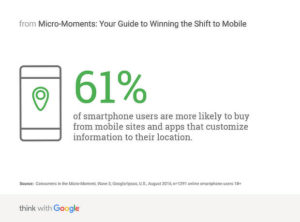Nearly every other week, a new marketing buzz word magically arrives on the scene. It’s the new, hot thing that everyone wants to talk about, at least until the next buzz phrase comes along and takes its place. But it’s not all just talk and catch phrases. Sometimes a marketing buzz phrase can actually be useful, once you dig more into it. Geofencing marketing, for example, has been a hot buzz word in marketing for a few years now. But what does that term actually mean, and more importantly, is it right for your business? First, let’s examine what it means. Geofencing marketing is a type of marketing that uses location-based data to request placement of an advertisement to a device. (More details on how it works here.) The geofence allows you to create the perimeter that works best for your needs. When would someone want to use location data to target their advertising? The reasons can range from a business’ current service area to a growth or prospect area. So when is geofencing marketing a good fit for your business as a promotional tactic? As a geofencing marketing company, you might expect us to say “all the time!” But the reality is that it’s going to depend on your specific objectives. We want to help companies find the right audience for their message using all the tools available to them. This could include using location based marketing tools like geofencing, but sometimes it does not.
Is geofencing marketing right for your strategy? Answer = Not always. Let us explain why in 4 bullet points below.
When is geofencing marketing a good fit?
- You know where your perfect audience is going to be and when. For example, if your business sells running shoes and clothing, then the Boston Marathon may be a good place to target. But sometimes other places can be great branding locations as well, such as gyms and parks with popular running trails.
- Around your coverage area – A good example of when geofencing marketing is a good fit is when you have a very specific service area. By using a geofence, you can reduce ad waste by covering only that area and not the entire surrounding areas that sometimes can occur with other forms of marketing such as TV, print publications and radio.
When is geofencing marketing not right?
- Focusing too small. For example, you sell a product in store and think it is a good idea to target only the perimeter of that store. Granted this is a viable solution, but we would recommend a different approach with maybe finding an audience of users more active or over all better quality.
- Focusing on competition when customers aren’t really there. If you are a service-based business, unless you are trying to target and recruit employees, you do not need to target your competition. For example, a financial advisor would be better suited targeting exact or interest category placements verses the competition’s offices. There are better places to put your ads such as industry-centric placements or apps or sites that carry a larger audience with similar interests as your potential customers. Thumbvista can help you find this audience.
Location Targeting Is Effective
It is proven that ads based on location are more commonly acted on than others. In a study from Google 61% of smartphone users will be more likely to purchase from an app/site when content is relevant to their location.

You do have other mobile marketing options for targeting.
Options other than hyper-local geofencing do exist that are very effective in finding the right audience. They range from contextual targeting, interest-based, whitelisting, and private market place buying. Using the financial advisor example above, we can still find a rich audience placing ads on MarketWatch verses focusing in on your competition’s financial advisor office locations.
Not all geofencing marketing companies are the same.
There are many companies out there that will just set you up on canned auto pilot campaigns. Some are not able to think outside the geofence box and know little about what really happens behind the scenes of an ad-serving environment.
Thumbvista takes extra steps in protecting our customers verses bots and ad fraud. New upstart apps or sites are always trying to dupe the system with the latest tricks and technologies to monetize their properties as much as possible. Let us become your trusted advisor in this ever-changing space. Contact us today.

